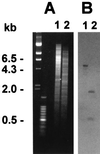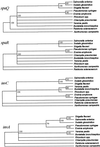The insect endosymbiont Sodalis glossinidius utilizes a type III secretion system for cell invasion
- PMID: 11172045
- PMCID: PMC29351
- DOI: 10.1073/pnas.98.4.1883
The insect endosymbiont Sodalis glossinidius utilizes a type III secretion system for cell invasion
Abstract
Sodalis glossinidius is a maternally transmitted secondary endosymbiont residing intracellularly in tissues of the tsetse flies, Glossina spp. In this study, we have used Tn5 mutagenesis and a negative selection procedure to derive a S. glossinidius mutant that is incapable of invading insect cells in vitro and is aposymbiotic when microinjected into tsetse. This mutant strain harbors Tn5 integrated into a chromosomal gene sharing high sequence identity with a type III secretion system invasion gene (invC) previously identified in Salmonella enterica. With the use of degenerate PCR, we have amplified a further six Sodalis inv/spa genes sharing high sequence identity with type III secretion system genes encoded by Salmonella pathogenicity island 1. Phylogenetic reconstructions based on the inv/spa genes of Sodalis and other members of the family Enterobacteriaceae have consistently identified a well-supported clade containing Sodalis and the enteric pathogens Shigella and Salmonella. These results suggest that Sodalis may have evolved from an ancestor with a parasitic intracellular lifestyle, possibly a latter-day entomopathogen. These observations lend credence to a hypothesis suggesting that vertically transmitted mutualistic endosymbionts evolve from horizontally transmitted parasites through a parasitism-mutualism continuum.
Figures




Comment in
-
Bacterial menageries inside insects.Proc Natl Acad Sci U S A. 2001 Feb 13;98(4):1338-40. doi: 10.1073/pnas.98.4.1338. Proc Natl Acad Sci U S A. 2001. PMID: 11171951 Free PMC article. No abstract available.
References
-
- Hentschel U, Steinert M, Hacker J. Trends Microbiol. 2000;8:226–231. - PubMed
-
- Steinert M, Hentschel U, Hacker J. Naturwissenschaften. 2000;87:1–11. - PubMed
-
- Corsaro D, Venditti D, Padula M, Valassina M. Crit Rev Microbiol. 1999;25:39–79. - PubMed
-
- Frank S A. Proc R Soc Lond B. 1996;263:339–344. - PubMed
-
- Frank S A. Evolution (Lawrence, KS) 1993;47:1721–1732. - PubMed
Publication types
MeSH terms
Substances
Associated data
- Actions
- Actions
Grants and funding
LinkOut - more resources
Full Text Sources
Other Literature Sources
Miscellaneous

